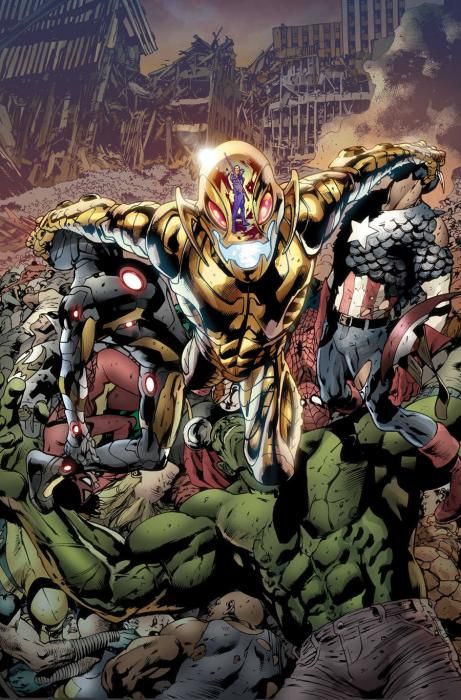For all the hype and anticipation leading up to "Age of Ultron" #1, the actual issue written by Brian Michael Bendis with art from Bryan Hitch, Paul Neary and Paul Mounts falls short on spectacle. It's obvious from the cover that Ultron's the big bad in this story, but Ultron isn't as much a direct threat within this issue as the threat of Ultron simply being a threat is. That makes this issue fueled by paranoia, but given the number of times Ultron has been defeated, the menace in this comic book just doesn't seem substantial out of the gate.
I'm certain Bendis will get to the "why" of Ultron being a threat in due time, but it isn't delivered in this issue. There is no legitimate cause behind the squalor populating the pages of "Age of Ultron" #1, just lots of speculation and guessing as "Age of Ultron" #1 presents samples of humanity at its worst. Bendis opens the adventure in the middle and works to construct the ends around it, but draws the reader to Hawkeye instead of Ultron. This installment is a study in Hawkeye's legitimacy as a hero more than anything else and provides a quick long-range synopsis of what the world looks like.
Hitch's art is to expectation, but with so many characters in altered states from their "current" appearances, there is a great deal of sameness floating about. This gets complicated further because the storytelling is muddy. Everyone moves the same way, has similar builds and doesn't distinguish themselves from one another, save Hawkeye and possibly Iron Man. Paul Mounts' usually vibrant coloring is muted here, in part from the circumstance I'm sure and part from the setting. That doesn't do Hitch's work any favors when there are scads of browns, greens and grays being liberally applied to accentuate the hopelessness of the landscape. Hitch, Neary and Mounts come together nicely to apply a vibration effect to an attack from Ultron drones. The sameness is undercut by the scope of the visuals for this dim new world. In this twenty-nine-page story, there are three drawings that cover six pages, lavishly detailing the wreckage of this drama. Hitch plays to his strengths further by including another three splash pages to communicate the emotions of the characters present. Throughout the entire issue, panels are constructed for widescreen impact, which magnifies the adventure represented.
Marvel makes no pretense about how large this story is. With an interesting collection of characters, this is certainly an event book that will garner attention, but this issue just isn't amazing. There are still, however, nine parts to go. Bendis' work tends to read better in chunks, without waiting between installments, and "Age of Ultron" #1 seems to follow in that trend. The cliffhanger of this issue is more of a page-turning cliffhanger than an issue-ending conclusion. I'm sure there will be plenty of readers who get a kick out of this opening chapter, but I might go back and re-read some of the other Ultron tales that Timothy Callahan mentions in his latest column before I re-read "Age of Ultron" #1. Maybe that will help me find a deeper appreciation for Hank Pym's most dangerous creation after this issue's letdown.

